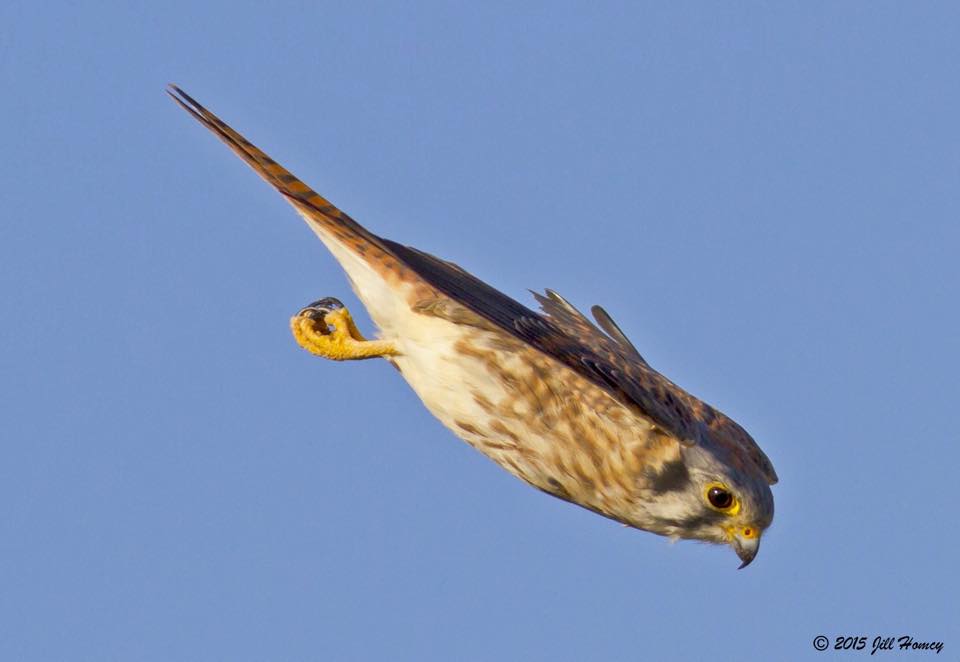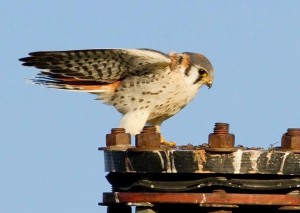The decline of a species is a very insidious affair. Their departure almost seems to go unnoticed until it sneaks up on you when you least expect it. It feels as if when no one is watching you wake up one day and realize you no longer see the bird you once loved as often as you have in the past. Then you begin to look around and wonder why, and ask what could have happened ?
In reality, of course, the deterioration of a species of wildlife does not happen overnight and usually has multiple causes, but the warning signs are always there waiting to be found. The American Kestrel is one of those species that holds a special place in my heart. Unfortunately, while it once graced the skies of the Meadowlands, it has now sadly seen a dramatic decline in a very short time.
For those growing up in the Meadowlands, the American Kestrel, our smallest falcon, was a pretty common sight. I can remember picking up my brother from a summer job he had working at a warehouse in Secaucus and watching nesting Kestrels up in the rafters. I recall standing at a local store in Moonachie and gazing up at a Kestrel with a freshly killed sparrow in its talons and pointing it out to my friends, who in those days for some reason were much more interested at looking at the local girls rather than the local birds. But it seems that the Meadowlands is not the only place where the American Kestrel has declined.
Some studies show that kestrels have declined by an estimated 1.5 percent each year between 1966 and 2010. The long-term loss may be as high as 50 percent of the population. That’s a big drop for a bird once considered abundant in the Northeast. Multiple factors have led to the decline of the Kestrel:
Habitat loss – Kestrels prefer open areas that have short ground vegetation and sparse trees where they hunt prey such as insects, mice, small songbirds, and even snakes and frogs.
Constant Exposure to pesticides that build up in their food sources have a devastating effect.
Lack of nesting sites – Since American Kestrels are cavity nesters like woodpeckers, the lack of available nest sites and competition by European starlings have hurt their numbers.
Modern farming practices that remove the trees and brush that make good places for the birds to nest and hunt have added to the problem. And now new studies may show evidence that flame retardant chemicals in the environment may be causing a problem with their eggs much like DDT did back in the 1960s. Things are not easy for the kestrel to say the least.
Melanie Mason from NJ Division of Fish and Wildlife told me that “kestrels are on the decline in the northeast and were recently added to NJ’s “Threatened” list. NJ Division of Fish and Wildlife’s Endangered and Nongame Species Program (ENSP) has been conducting its American Kestrel Nest Box Program since 2006 to provide nesting sites for Kestrels- one of the theories behind their decline- as well as monitor their breeding success in New Jersey.
“Kestrels are obligate secondary cavity nesters so when natural cavities (such as old woodpecker holes) are not available, they are unable to successfully breed. Dead tree/snag removal as well as nest site competition with nonnative European starlings minimize the availability of the cavities since the kestrels do not excavate their own holes. Kestrels readily accept “man-made” nest boxes and since part of the ENSP nest box monitoring protocol involves dissuading starlings by periodically removing their nests, kestrels get the added benefit of reduced starling competition as well.”
Fortunately with the preservation and improvement of the NJ Meadowlands we still retain good habitat for the American Kestrel in our area. Kestrels can still be seen in DeKorte Park in Lyndhurst, Mill Creek Marsh in Secaucus, and River Barge Park in Carlstadt, all of which provide good foraging places for our little falcon. But much more still needs to be done to give this magnificent raptor a helping hand here in New Jersey.
More nesting boxes need to be provided, habitat needs to be protected and managed correctly to benefit the Kestrel, and we all need to work toward a much cleaner and pesticide free environment that will benefit us all .
Read more about kestrels, the nest box program, and other Endangered, Threatened, and Special Concern species at http://www.conservewildlifenj.org/species/spotlight/kestrel/
If you see a kestrel in New Jersey- especially during the April-July breeding season- please fill out a “Species Sighting Form” at: http://www.nj.gov/dep/fgw/ensp/rprtform.htm



Oh no, really. I am taken aback by this Don. Can we do more nest boxes, like we do for the swallows?
We are attempting to work on that as we speak , hopefully in 2016 we can get a project going
I was witness to a traumatic incident. My father and I were going home in the family car and all of a sudden a beautiful kestrel just hit our windshield. I dont know what it was that made him do it, but it almost seemed as if the bird divebombed the car. The only thing i can think of is that perhaps there was a mouse or other prey crossing the street and our car occupied the space the mouse etc was in just as it divebombed and could no longer back out. It was a sickening sound as the bird hit the windshield. I think it must have died immediately. It hit the windshield so hard that one of its eyes popped out. I was so shocked and then saddened by what happened. When i got home i wept in the privacy of my bedroom. It was such a magnificent creature. The windshield had to be replaced. This happened about 6 years ago in North Bergen going down the hill on 78th st very near the intersection with Tonnelle Ave. It must’ve flown in from the meadowlands which are nearby.